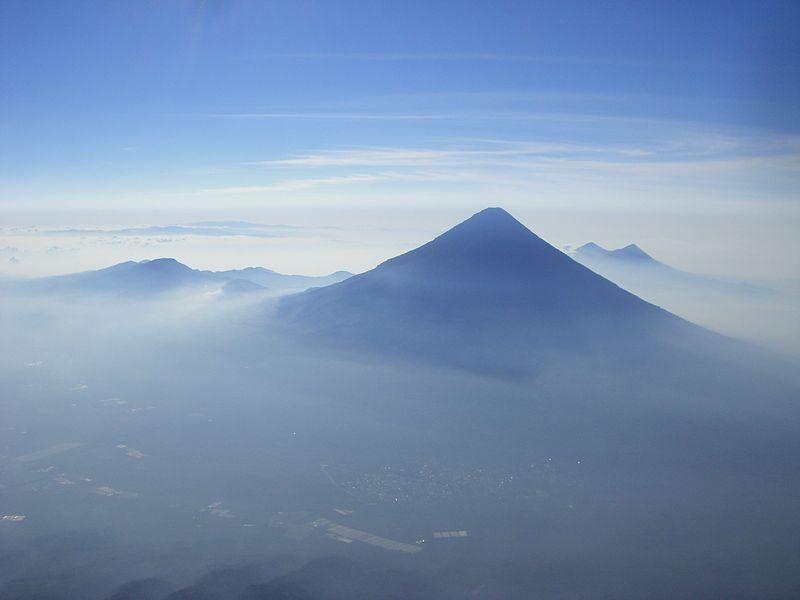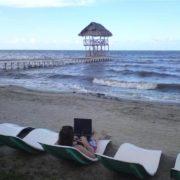Guatemala Volcanic Neighbors Include Volcan de Agua & Fuego
Guatemala our Volcanic Neighbors Include Volcan de Agua & Fuego (both dormant) and Fuego which is famous for being almost constantly active at a low level.
From my garden in Antigua, I am able to see all three of these spectacular natural wonders and for years now I have enjoyed waking up and gazing at them while having my morning coffee. Of course Fuego is the most fun to watch because it is often “puffing away” and it can sometimes put on a very dramatic show with its “blasts” of ash and smoke plumes.
Fuego’s most recent major eruption occurred on Sunday, April 23, 2017 and this extraordinary event was something I was lucky enough to see with my very own eyes! For a full day and night – without interruption – Fuego violently spewed lava, rock and ash. I spent nearly the entire night of in my garden watching this astounding display of volcanic power and beauty.
A column of bright red lava shot straight into the air, as high as a skyscraper, and continued to do so for nearly 24 hours. In my life I have never seen anything as amazing and awe-inspiring as Fuego’s eruption.

Volcan de Agua & Fuego
After this incredible experience, I was motivated to do a little research on Fuego. The following are a few things – both interesting and disturbing – that I discovered about our volcanic neighbor:
* Fuego has had more than 60 eruptions since 1524 with 25% of these eruptions involving significant lava flows.
* Even more “major” than the 2007 eruption was Fuego’s October 1974 eruption. With this event there was a series of powerful blasts that produced up to 10km high ash columns and multiple pyroclastic flows. The longest flows reached over 10km but were fortunately restrained in uninhabited valleys. Thousands abandoned their homes due to this eruption and many roofs collapsed under the weight of the ash that was deposited. Additionally many local crops and grazing areas were destroyed by the ash layer.
* Fuego was essentially quiet from 1987 to 1999, but it is now experiencing a period of ‘heightened’ activity. The most common activity is sporadic, small eruptions that produce ash clouds (events like this can be minutes or days apart), but in more recent years lava flows have become more common and at night incandescence can often be seen at the base of eruption column.
Future eruptions are, of course, hard to predict but you do not have to look any further than Fuego’s sister volcano’s history, Agua, to get a glimpse of what could happen…

Volcan de Agua & Fuego
Volcán de Agua, which dominates the local landscape of Antigua, has been inactive since the mid 16th century. In 1541, however, Agua’s volcanic activity triggered a mudflow of biblical proportions and the nearby “original” Antigua (now known as Ciudad Vieja) was completely destroyed and many lives were lost. This event is the reason Antigua was “moved” to its present location.
With any luck, Fuego will not repeat Agua’s destructive past and our beautiful home of Antigua will be spared. In fact, I feel confident that Fuego will continue to safely entertain us with low level eruptions for many years to come.
If, however, Antigua is destined to be destroyed once again by a volcanic event, I can only hope that when it happens I will be surfing with friends in El Salvador! Of course since Guatemala sits at the center of three tectonic plates, Antigua could always be destroyed by one of the country’s frequent earthquakes, but I think I will save that for another blog…
Note – Guatemala has 33 volcanoes of which three are active.
Volcan Fuego is not accessible to hikers, but another nearby active volcano (Pacaya) is and it is one of Guatemala’s most popular tourist attractions. Just an hour’s drive from Antigua, Pacaya offers visitors the extraordinary experience of seeing hot, flowing rivers of lava up close!


 Grow Your Own Cure
Grow Your Own Cure  Lake Atitlan Tours
Lake Atitlan Tours  Grow Your Own Cure
Grow Your Own Cure 
 Grow Your Own Cure
Grow Your Own Cure  Lake Atitlan Tours
Lake Atitlan Tours 
